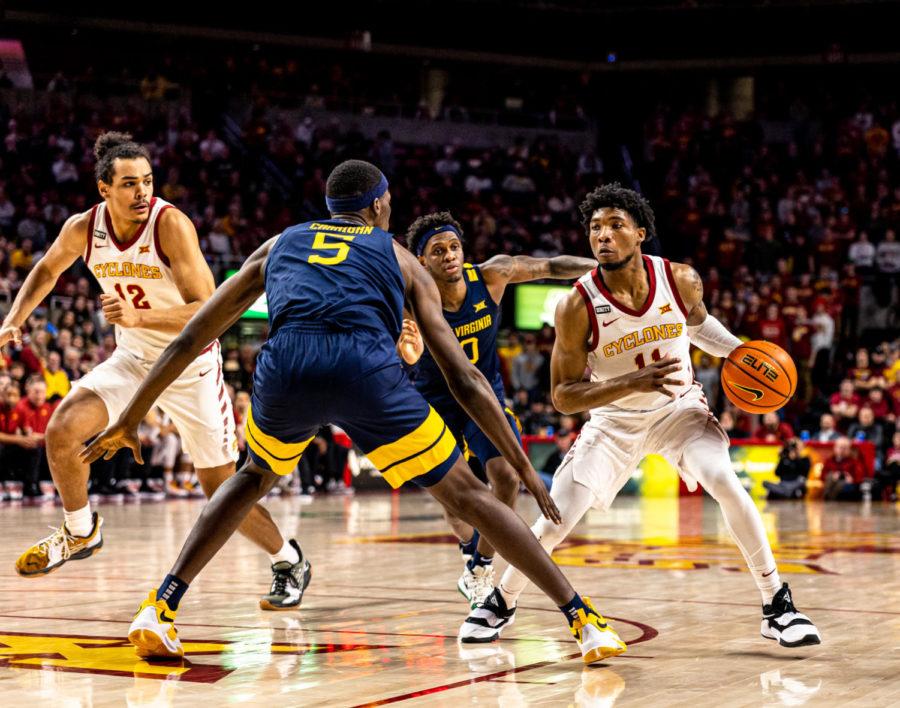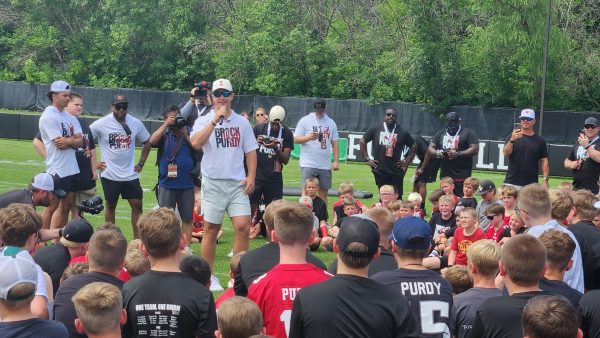Three Big Takeaways: Cyclones shoot past Mountaineers after slow start
Collin Maguire/Iowa State Daily
Tyrese Hunter looks to attack against the Mountaineers on Feb. 23. 2022
February 23, 2022
AMES — The first three-game win streak in Big 12 regular-season play since Jan. 30 to Feb. 4 of 2019 hasn’t come without its challenges.
But it may have unlocked something for Iowa State, who now sits at 6-9 in Big 12 play with three games remaining. They’ve put up their two highest offensive outputs in conference play, and Gabe Kalscheur has begun to find something in his game to compliment the defense he has brought all season.
The Cyclones defeated West Virginia, 84-81, in what was a foul-heavy, physical evening at Hilton Coliseum.
It was Izaiah Brockington’s fall-away jumper with 22 seconds left and Kalscheur’s two free-throw makes with eight seconds to go that sealed the deal for Iowa State. Brockington finished with a career-high 35 points, none bigger than his final two.
The start wasn’t the prettiest, the game wasn’t the smoothest, but the crowd may have been at its rowdiest in the pen-ultimate game at Hilton Coliseum this season.
Physical first half favors the Mountaineers
To say the first 20 minutes were physical would be like saying Mountaineer head coach Bob Huggins gets a bit agitated at the officials sometimes.
It was a bruising half that featured 23 total fouls called and 26 total points in the paint.
Iowa State has continuously preached about being the aggressor early on in games. T.J. Otzelberger conceded that the first half was a physical one, but it was also a product of turning the ball over often.
“The game was physical in the first half for sure,” Otzelberger said. “In the second half, we had 13 assists so we didn’t turn the ball over, so we ran good offense in the second half. I’ll leave it at that.”
The Cyclones committed nine turnovers and only dished out six assists. In the second half, they didn’t turn the ball over a single time and had the 13 assists Otzelberger alluded to.
West Virginia, a team well-known for its physical nature under Huggins, got to the line 14 times in the first half. They had 16 paint points compared to just 10 for the Cyclones and outrebounded them 19-9.
As for the second half, Iowa State out-scored the Mountaineers 14-10 in the painted area and the Cyclones shot 19 second-half free throws compared to 13 for West Virginia.
The Cyclones’ second-half surge was not just aided by their ramped-up aggression, but also by the 53 points they managed to put up on the offensive end.
Back-to-back second half explosions
Iowa State will never be confused this season for an offensive powerhouse. But if the casual fan only watched the last two games for the Cyclones, they could think otherwise.
The 53 points in the second half against West Virginia was the most in any half for Iowa State since Nov. 28, 2019, in the second half against Alabama in the Battle 4 Atlantis.
Pair that with the 75 points put up against Oklahoma on a hot afternoon from the field, and Otzelberger may have found some semblance of an offensive attack after losing it for long stretches of games early in Big 12 play.
“If our guys can play offensively with the confidence they’ve had the last two second-halves and share the ball the way they have, we can be pretty special,” Otzelberger said.
Iowa State shot 63 percent from the field in the final 20 minutes against the Mountaineers, as well as making 52 percent from three-point range. They’ve shot over 50 percent from the field in back-to-back games for the first time this season.
T.J. Otzelberger has rarely been able to hang his hat on offensive firepower carrying his team to victories, but it’s been the calling card for his team in their last two games at Hilton Coliseum.
Kalscheur comes up clutch
“I feel like I kept us in it, but Gabe’s shots were huge… they were daggers,” Brockington said.
“Cold. Cold-blooded,” he added when talking about Kalscheur’s performance.
It was a long-time coming for the transfer from Minnesota. He had made just seven of his 48 attempted threes since his break-out game against Texas on Jan. 15, good for 14 percent.
His production from three-point range had all but disappeared, and it resulted in him shooting no more than five threes in a game over his last six outings.
Against the Mountaineers, Kalscheur’s shot was “cold,” as his teammate Brockington put it. This time, in a good way.
Kalscheur had 17 points on six of 10 shooting, and he made three of his five from distance. It was his two threes, with 2:22 and 1:45 remaining, as well as his two-free throws with eight seconds to go, that were the biggest of the game.
Otzelberger has never doubted his starting guard and emphasized the importance of the continued trust he put in Kalscheur even when the shots weren’t falling.
“Really cool to see for Gabe,” Otzelberger said after the performance. “It hasn’t always gone his way shooting it from the perimeter… as a coach you want to continue to instill that confidence in your guys for key moments.”
“He earns it every day, and he deserves to make shots like that based on how he works.”

















